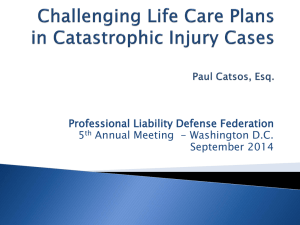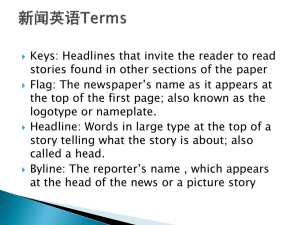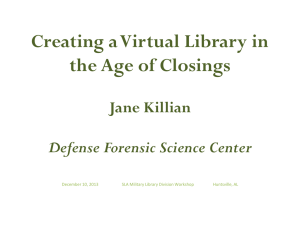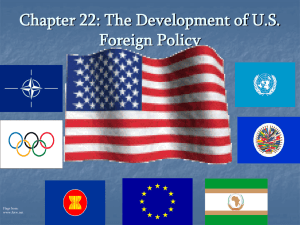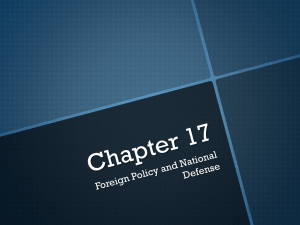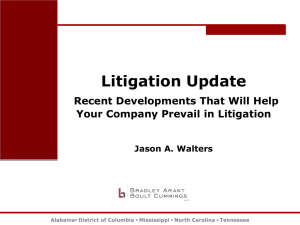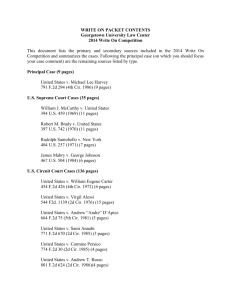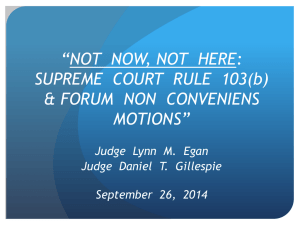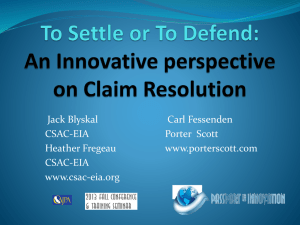The Gauntlet: Early Challenges to Class Certification
advertisement
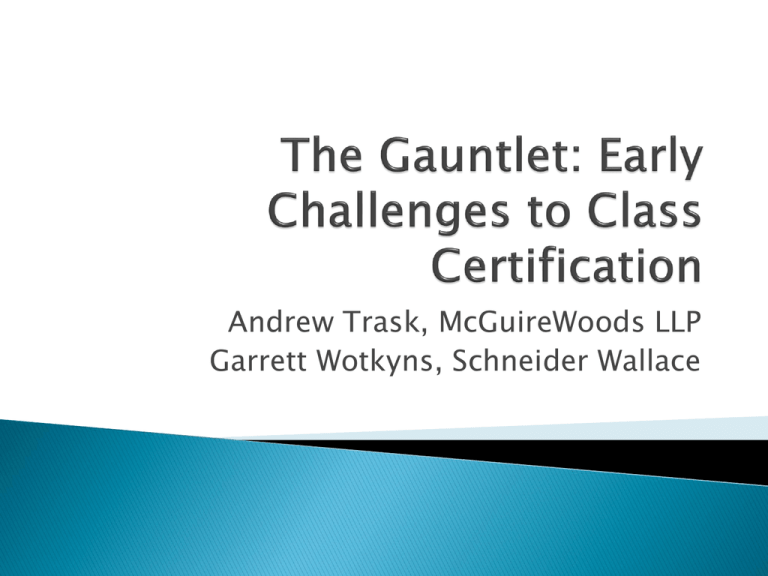
Andrew Trask, McGuireWoods LLP Garrett Wotkyns, Schneider Wallace Trask is not British We know each other well We are University of Chicago grads There will be no mention of Mazza All of these cases are in the written materials ◦ But Wotkyns is half-Czech. ◦ So there has been collusion. ◦ So we are deeply nerdy. ◦ And pretty cynical. ◦ And we say “incentive” a lot. ◦ Except this one. ◦ But the slides will go up on www.classactioncountermeasures.com today. Trans-substantive – one size fits all Rule 23(a) Rule 23(b) ◦ ◦ ◦ ◦ (1) (2) (3) (4) numerosity – how big is this case really? commonality – will we get a single answer? typicality – is the plaintiff a special snowflake? adequacy – who’s the plaintiff working for? ◦ (1) – zero-sum games ◦ (2) – declaratory or injunctive relief ◦ (3) – damages Predominance – Just how many special snowflakes are there? Superiority – Can’t we hand this off to someone else? Class certified = ◦ Heavy incentive for defendant to settle ◦ Scope of case finally defined Class denied = ◦ Individual lawsuit, resulting in Smallish settlement or Voluntary dismissal Is to make the class proposal look like this. (Sondra Locke optional.) Class proposal Early challenges Class certification motion Motion to Deny Certification Early Summary Judgment Discovery Battle Motion to Strike Motion to Dismiss Procedural challenges (or direct challenges) ◦ Look to win the game outright Motion to Deny Motion to Strike Substantive challenges (or indirect challenges) ◦ Look to rearrange the chessboard Summary Judgment Discovery battles Motion to Dismiss Defense faces incentive to challenge early ◦ Dukes has frontloaded discovery costs ◦ In-house counsel have been asked to do more with less “In 2012, corporate legal departments expect to handle slightly more of them—on average, 5.4 matters per company, up from 4.4 in 2011. At the same time, they plan to decrease their per suit costs, which average $776,500, by 17 percent this year.” (Carlton Fields survey) Vinole v. Countrwide Home Loans, Inc., 571 F.3d 935, 939 (9th Cir. 2009) (“Rule 23 does not preclude a defendant from bringing a ‘preemptive’ motion to deny certification.”). Defense Advantage: ◦ Allows defendant to frame debate. ◦ Allows defendant reply brief. Defense Risk: ◦ Tips hand to plaintiffs on arguments. ◦ If court denies on procedural grounds, 1 motion for the price of 2. Focused on plaintiff-specific issues. ◦ Wright v. Schock, 742 F.2d 541, 543-44 (9th Cir. 1984) (court properly ruled on summary judgment before certification because (1) resolution protected parties from needless and costly litigation and (2) parties did not suffer prejudice by early determination on merits). “These are not the droids you are looking for.” ◦ Named plaintiff not injured/not member of class. ◦ Early rehearsal of adequacy/typicality. “Please deny this motion.” ◦ Attack on causation. (e.g., plaintiff did not rely on representation) ◦ Early attack on commonality/predominance. ◦ Defense Advantage: Win on merits, no case. Lose on contested material facts, sets up variations for class certification. ◦ Defense Risk: Adverse decision on merits – legal grounds. Heerwagen v. Clear Channel Communications, 435 F.3d 219 (2d Cir. 2006). ◦ Limitation of discovery OK because “plaintiff failed to make any showing, however preliminarily, that she could satisfy the predominance requirement of Rule 23(b)(3) or that she might be able to do so with additional discovery.” (234) Mantolete v. Bolger, 767 F. 2d 1416 (9th Cir. 1985). So defense can use discovery objections to force debate on scope of class. ◦ “[T]he plaintiff bears the burden of advancing a prima facie showing that the class action requirements of Fed. R. Civ. P. 23 are satisfied or that discovery is likely to produce substantiation of the class allegations.” (1424) Defense Advantage: ◦ Possible to limit discovery (& limit cost) ◦ Possible to limit scope of class ◦ Can force early debate on dubious classes Defense Risk: ◦ Courts don’t like discovery disputes. ◦ “Rigorous analysis” implies plaintiffs need evidence. John v. Nat’l Sec. Fire & Cas. Co., 501 F.3d 443, 445 (5th Cir. 2007) (“Where it is facially apparent from the pleadings that there is no ascertainable class, a district court may dismiss the class allegation on the pleadings.”). Variations in state law - Pilgrim v. Universal Health Card, LLC, 660 F.3d 943, 946 (6th Cir. 2011). Incurable problems with class definition - John v. Nat’l Sec. Fire & Cas. Co., 501 F.3d 443, 445 (5th Cir. 2007). Better alternatives out there – Kamm v. Cal. City Dev. Co., 509 F.2d 205 (9th Cir. 1975) (previous AG settlement justified motion to strike). Individual causation/reliance - Schilling v. Kenton County, 2011 U.S. Dist. LEXIS 8050 (E.D. Ky. Jan. 27, 2011) ("to resolve the legal issue presented the Court must delve into the specific facts of each inmate's incarceration and the medical needs relative to that inmate."). Defense Advantage: ◦ Early defeat of certification ◦ Defendant gets to frame issues Defense Risk: ◦ Could be denied as premature See, e.g., Eliason v. Gentek Building Prods., Inc., 2011 U.S. Dist. LEXIS 94032, *7 (N.D. Ohio Aug. 23, 2011) (“While raising possibly valid concerns, Defendants' arguments on class certification are premature.”) ◦ Tips plaintiffs off to arguments Specific motions have specific Rule 23 criteria they help ◦ ◦ ◦ ◦ ◦ ◦ Standing – Adequacy Preemption - Superiority Sufficiency of allegations – Commonality Plaintiff-specific problems – Typicality/commonality Availability of injunctive relief – Rule 23(b)(2) Availability of attorneys’ fees – Plaintiffs’ reason for being Defense Advantage: ◦ Early resolution of case ◦ Educate judge on individualized issues ◦ Shape class cert briefing Defense Risk: ◦ Early determination that issues are common In re Bridgestone/Firestone, Inc. Tires Prods. Liab. Litig., 205 F.R.D. 503 (S.D. Ind. 2001). (subsequent certification overruled)
